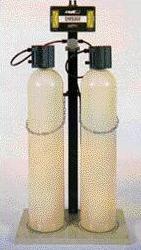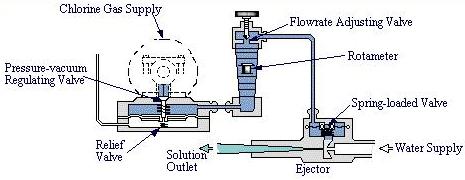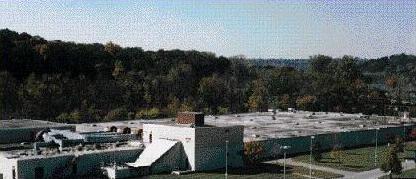Chlorinators supply chlorine as a high-pressure liquefied gas to disinfect a water supply.
General Information
Chlorine is available commercially as a liquified gas under pressure. Chlorinators meter the chlorine gas flow and dissolve the chlorine in some water. The resulting solution is then added to the water to be disinfected. Pictured below is a dual cylinder chlorinator unit.

Equipment Design
In a “pressure” type system chlorine enters through a pressure-vacuum regulating valve, passes by a relief valve, then travels through a rotameter and a flow rate adjusting valve. Pressure-vacuum regulating valves are designed to maintain a constant pressure (usually a vacuum). They also serve as a check valve in the event of ejector vacuum loss. Relief valves prevent buildup of chlorine pressure within the system. Water under pressure passes through an ejector, creating a vacuum. This vacuum opens a spring-loaded valve in the ejector body. When the valve opens, chlorine mixes with water in the ejector to form a chlorine solution that is then ejected into the water being treated.

In vacuum systems, the vacuum created by the water pulls a diaphragm, which pushes open a spring-loaded inlet valve. Chlorine gas is drawn from the cylinder, through the chlorinator, through the vacuum tubing, and into the ejector. There it mixes with water and is ejected into the water being treated.
Usage Examples
Chlorinators are used mainly in wastewater and water disinfection. They are used extensively in wastewater treatment plants such as the one shown here.

Advantages
- Can handle variable flow rates
- Dosage rates and resulting chlorine residual can be accurately controlled
- Extremely reliable
- Less costly than other disinfection systems
Disadvantages
- Use of chlorine can cause safety hazards
Acknowledgements
- Ann Arbor Wastewater Treatment Plant, Ann Arbor, MI
- Chlorinators, Inc., Stuart, FL
- Modern Process Systems, Inc., Baton Rouge, LA
References
- White, George Clifford. The Handbook of Chlorination. New York: Van Nostrand Reinhold Company, 1986: 655-681.
Developers
- Melissa Schlosser

